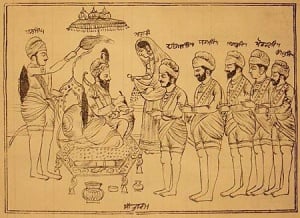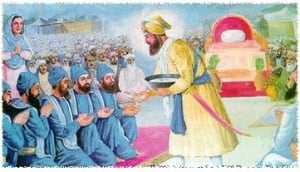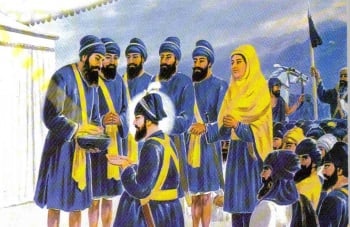Vaisakhi
Vaisakhi (Punjabi: ਵੈਸਾਖੀ or ਵਸਾਖੀ, vaisĝkhī, is, as well, known as Baisakhi), it is a very important day for Sikhs and one of the most colourful events in the Sikh calendar. It occurs during mid-April every year and traditionally concurs in Punjab with the first harvesting of the crops for the year. So, historically, it has been a very joyous occasion and a time for celebration. However, since 1699, it has marked the very significant religious event of the creation of the Khalsa Panth.
Vaisakhi falls in the Nanakshahi calendar on the first day of the Vaisakh month and marks the sun's entering of Mesha Rasi (this fact is called Mesha Sankranti, i.e. the solar transits into Aries). Vaisakhi is therefore determined by the solar calendar. Baisakhi usually falls on April 14, and on April 15 once every thirty-six years, however, it has now been agreed for Vaisakhi to always fall on the 14th of April. It is not, as commonly believed, a New Year for the Sikhs. This Sikh New Year is celebrated on the 1st day of Chet which usually falls on March 13, a month earlier.
History of Vaisakhi
Religious persecution under Aurangzeb
A younger son of Shah Jahan, Aurangzeb, seized the Gaddi (Throne) of the Mughal Empire from his brother Dara Shikoh, arrested his father and took the Imperial name of Alamgir I (seizer of the Universe, besting his father who had styled himself Grabber of the World) in 1657. His coming to the throne had been costly for his family members, now it would become a disaster for the people of India and those who dared to challenge his policy of religious persecution as he set in motion the process of the Islamization of India.
The Brahmins were his primary target but he reinstated the unethical religious tax, that Akbar had ended, on the Hindus. Their temples and places of learning were shut, torn down and often replaced with Masjids, often built from the stones of the Hindu Temples. He had been convinced by the powerful ulama, whom his predacessors had largely ignored, that once the highly respected Brahmins of Kashmir accepted Islam, the Hindus of all castes would then follow suit.
1675: The fight against subversion
The Brahmins of Kashmir were given an ultimatum— convert or die. Thoughts of death, rape and torture for themselves and loved ones weighed heavily on their minds. When the time allotted for their answer was almost up, they looked for a dynamic leader to help in their fight against subversion.
The Kashmiri Brahmins, led by Pandit Kirpa Ram sought the intervention of Guru Tegh Bahadur, the ninth Nanak or preceptor of the Sikh religion — the Dasvin Patishah or Guru, in his new city, near the ruins of ancient Makhowal, — today's Anandpur Sahib. They asked him for guidance on combating the atrocities being committed by the Mughal Emperor.
At the time of their meeting, Guru Tegh Bahadur's nine year old son, Gobind Rai, was sitting beside him. As Guru Tegh Bahadur was deep in contemplation, thinking of the problem, his young son asked the reason of his concern. Guru Tegh Bahadur said that the matter was of vital importance; the world is aggrieved by oppression; and no brave man had yet come forward who was willing to sacrifice his life to free the earth from the burden of Aurangzeb's persecution. Young Gobind Rai replied, "For that purpose who is more worthy than you my father." So after entrusting the Guruship to Gobind Rai, Guru Tegh Bahadur and several of his Sikhs proceeded to Delhi, the seat of the Mughal Empire. But, before reaching Delhi, the Guru and his loyal attendants were arrested and put in chains by the agents of the Mughal Ruler Aurangzeb.
The martyrdom of Guru Tegh Bahadur
While in prison, Guru Tegh Bahadur foresaw the beginning of his ecclesiastic journey. To test his son's courage and capability to carry on the Guru's mission, he wrote him saying, "My strength is exhausted, I am in chains and I can make not any efforts. Says Nanak, God alone is now my refuge. He will help me as He did his Saints." In reply young Guru Gobind Rai wrote: "I have regained my Power, my bonds are broken and all options are open unto me. Nanak, everything is in Thine hands. It is only Thou who can assist Thyself."
Guru Teg Bahadur offered his life for the freedom of all, not just his own group of Sikhs, but for those of another religion to be able to freely choose when, where and how they would hold their worship. His spirit of sacrifice and courage kindled a similar spirit in the heart of young Gobind Rai.
It was November 11, hundreds of people had gathered around Chandini Chowk where Guru Tegh Bahadur was martyred in Delhi. The executioner left the Guru's severed head and body to lie where they had fallen. In fear of a sudden sand storm he had run for shelter. No one stood up to claim the body of the fallen Guru or his companions who had died tortured deaths before his eyes. Who would perform the religious rites of these brave men. Even the most ardent disciples withdrew, unrecognized.
But, taking advantage of the stormy weather one man, a member of the Mazhabis, managed to take the severed head of Tegh Bahadur to his family back in Anandpur where the appropriate rites were given the noble Guru. Another man, assisted by his sons, secreted the Guru's body away before it would surely be quartered or hung on display by Aurangzeb's minions. They used their humble home as the Guru's secret funeral pyre, as any proper cremation would have brought down the wrath of the frustrated Aurangzeb on their heads. Aurangzeb had lost in this challenge to his plans--for Guru Tegh Bahadur had endured all of the tortures and lures that the mighty Aurangzeb could muster, niether he or any of his companions had taken the easier road and abandoned their religion and principles. Gobind Rai would now seek to endow each of his Sikhs with the iron will and fortitude of his father. For the moment the Pandits were safe, but Guru Gobind Rai now worked to prepare his Sikhs for the coming storm.
1675– : Guru Gobind Rai leads the moral struggle
With the criteria of courage and strength to sacrifice, Gobind Rai became the tenth Sikh Guru. He wanted to instill these principles in his downtrodden followers. He wanted to uplift their morale to combat the evil forces of injustice, tyranny, and oppression.
Every year at the time of Baisakhi (springtime), thousands of devotees would come to Anandpur to pay their obeisance and seek the Guru's blessings.
1699: Guru Gobind Rai (Singh) establishes the Khalsa

Guru Gobind Rai was 33 years old when he had Divine inspiration to actuate his designs. In early 1699, months before Baisakhi Day, Guru Gobind Rai sent special edicts to congregations far and wide telling all the Sangats that that year's Baisakhi was going to be a unique affair. He asked them not to cut any of their hair — to come with unshorn hair under their turbans and chunis, and for the men to come with full beards.
On Baisakhi Day, March 30, 1699, hundreds of thousands of people gathered around his divine temporal seat at Anandpur Sahib. The Guru addressed the congregants with a most stirring oration on his divine mission of restoring their faith and preserving the Sikh religion. After his inspirational discourse, he flashed his unsheathed sword and said that every great deed was preceded by an equally great sacrifice: Then calling out to the assembled crowd, 'My sword is hungry for a head', He demanded one head for oblation. After some trepidation one person offered himself for the Guru's 'great sacrifice'. The Guru took him inside a tent. A little later the Guru came out of the tent, his sword dripping with fresh blood only to ask for another head. One by one four more earnest devotees offered their heads. Every time the Guru took a person inside the tent, he came out with his sword dripping fresh blood.
Thinking their Guru had gone mad and afraid He would ask for more heads some of the congregation started to disperse when suddenly the Guru emerged with all five men dressed piously in white and in a new ceromony that changed the way that one became a Sikh the Guru now initiated the five into a new and unique order of Sikhs. The ceremony was called pahul, what Sikhs today know as the baptism ceremony or Amrit Shakna. Then the Guru asked the first five Khalsa Sikhs to baptise him, in the same manner. He then proclaimed that the Panj Pyare -- the Five Beloved Ones -- would be the embodiment of the Guru himself:
- "Where there are Panj Pyare, there am I. When the Five meet, they are the holiest of the holy."
And so, as it was carried out on that historic day, the ceremony of Pahul continues to this day.
The important thing to remember about that day is that the five volunteers and the whole sangat thought or were "under the impression" that the five Sikhs were really walking to their deaths--being killed, one by one. The Sikhs who volunteered, had demonstrated their willingness to give their heads--in the same way that Guru Tegh Bahadur had done that day in Delhi. The Guru's bit of showmanship, his seemingly--all to real test, was performed to prove the devotion and dedication of his Sikhs. Those who were ready to give themselves up to their Guru were the bravest and most devoted. These brave men had unkowningly chosen to be part of a new paanth - the Khalsa Panth. Guru ji joined the Khalsa Panth after his devoted Sikhs - the initiator becoming the initiated. Today, as then, they lead the Khalsa alongside the Guru:
- "Where there are Panj Pyare, there am I…"
He said whenever and wherever five baptised (Amritdhari) Sikhs come together, the Guru would be present. All those who receive Amrit from five baptized Sikhs will be infused with the spirit of courage and strength to sacrifice. Thus with these principles he established Panth Khalsa, the Order of the Pure Ones.
At the same time the Guru gave his new Khalsa a unique, indisputable, and distinct identity. The Guru gave the gift of bana, the distinctive Sikh clothing and headwear. He also offered five emblems of purity and courage. These symbols, worn by all baptised Sikhs of both sexes, are popularly known today as Five Ks: Kesh, unshorn hair; Kangha, the wooden comb; Karra, the iron (or steel) bracelet; Kirpan, the sword; and Kachera, the underwear. By being identifiable, no Sikh could never hide behind cowardice again.
Political tyranny was not the only circumstance that was lowering peoples' morale. Discriminatory class distinctions (--the Indian "caste" system--) promoted by Brahmins and Mullahs was also responsible for the peoples' sense of degradation. The Guru wanted to eliminate the anomalies caused by the caste system. The constitution of the Panj Pyare was the living example of his dream: both the high and low castes were amalgamated into one. Among the original Panj Pyare, there was one Khatri, shopkeeper; one Jat, farmer; one Chhimba, calico printer/tailor; one Ghumar, water-carrier; and one Nai, a barber. The Guru gave the surname of Singh (Lion) to every Sikh and also took the name for himself. From Guru Gobind Rai he became Guru Gobind Singh. He also pronounced that all Sikh women embody royalty, and gave them the surname Kaur (Princess). With the distinct Khalsa identity and consciousness of purity Guru Gobind Singh gave all Sikhs the opportunity to live lives of courage, sacrifice, and equality.
Celebration
The birth of the Khalsa is celebrated by Sikhs every Vaisakhi Day on April 13. Vaisakhi 1999 marks the 300th anniversary of Guru Gobind Singh's gift of Panth Khalsa to all Sikhs everywhere.
- WAHEGURU JI KA KHALSA, WAHEGURU JI KI FATEH!
See Also
External Links
Suggested Reading
1) Dasam Patshah di Vaisakhi - Sirdar Kapur Singh
2) Songs of Vaisakhi Ever Now (Sad Vasakhi Dian Sittha) - Sher Singh MSc Kashmir
3) Dashmesh ji da jalaali roop - Sirdar Kapur Singh
4) Dashmesh ji da jalaali roop (hindi) - Sirdar Kapur Singh
6) Khalsa Akal Purakh ki Fauj - Dr. Inderjeet Singh Vasu Tract No. 496
7) The Khalsa or the Elect - Sher Singh MSc Kashmir
8) Khalsa Ik Parvaar Tract No. 353
9) Khalsa Nirupan Tract No. 78
10) Khalsa Soi Karey Nit Jang Tract No. 109
11) Khalsey da Vikas Tract No. 7
12) Vaisakh Bhala Tract No. 134
14) Guru Gobind Singh's Amrit - The Eternalising Libation - Gyani Brahma Singh Brahma
15) Sri Guru Gobind Singh Ji - The Baptist Beyond Peer - Gyani Brahma Singh Brahma
16) City of Joy - Siri Anandpur Sahib - Harbans Singh


